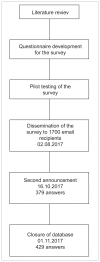Sedation Practices and Preferences of Turkish Intensive Care Physicians: A National Survey
- PMID: 31183469
- PMCID: PMC6537960
- DOI: 10.5152/TJAR.2019.49799
Sedation Practices and Preferences of Turkish Intensive Care Physicians: A National Survey
Abstract
Objective: Sedation is one of the most common practices applied in the intensive care units (ICUs), and the management of sedation, analgesia and delirium is a quality measure in the ICUs. Several guidelines on sedation had been published, and many surveys investigated the practices of sedation in the ICUs, but knowledge on the sedation practices in Turkey is lacking. The aim of the present study was to provide baseline knowledge on the sedation practices and preferences of Turkish intensive care physicians and to establish some points to be improved.
Methods: An electronic survey form consisting of 34 questions was generated and posted to email addresses. The survey included questions about demographics and practices on sedation, analgesia, neuromuscular blockage and delirium.
Results: Of 1700 email addresses, 429 (25.0%) were returned. Sedation was practised by 98.0% of the respondents, and mechanical ventilation was indicated as the primary indication (94.0%) for sedation. The presence of a written sedation protocol was 37.0%. For drug choices for sedation, midazolam was the most preferred agent (90.0%). With regard to pain questions, the most commonly used evaluation tool was Visual Analogue Scale (69.0%), and the most preferred drug was tramadol. Nearly half of the participants routinely evaluated delirium and used the confusion assessment method in the ICU.
Conclusion: The results of this survey have indicated some areas to be improved, and a national guideline should be prepared taking pain, agitation and delirium in focus. ClinicalTrials.gov ID: NCT03488069.
Keywords: Intensive care unit; practice; sedation; survey.
Conflict of interest statement
Conflict of Interest: The authors have no conflicts of interest to declare.
Figures
References
-
- Shehabi Y, Bellomo R, Reade MC, Bailey M, Bass F, Howe B, et al. Sedation Practice in Intensive Care Evaluation (SPICE) Study Investigators; ANZICS Clinical Trials Group. Early intensive care sedation predicts long-term mortality in ventilated critically ill patients. Am J Respir Crit Care Med. 2012;186:724–31. doi: 10.1164/rccm.201203-0522OC. - DOI - PubMed
-
- Barr J, Fraser GL, Puntillo K, Ely EW, Gélinas C, Dasta JF, et al. American College of Critical Care Medicine. Clinical practice guidelines for the management of pain, agitation, and delirium in adult patients in the intensive care unit. Crit Care Med. 2013;41:263–306. doi: 10.1097/CCM.0b013e3182783b72. - DOI - PubMed
Associated data
LinkOut - more resources
Full Text Sources
Medical



